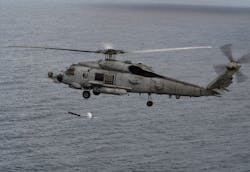U.S. Navy replenishes supply of AN/SSQ-62 sonobuoys with programmable sonar for anti-submarine warfare (ASW)
PATUXENT RIVER NAS, Md. – U.S. Navy anti-submarine warfare (ASW) experts are replenishing their supplies of advanced air-launched sub-hunting sonobuoys that work together with other sonobuoys to detect, pinpoint, and track enemy submarines.
Officials of the Naval Air Systems Command at Patuxent River Naval Air Station, Md., announced a $8.4 million order Thursday to ERAPSCO in Columbia City, Ind., for as many as 5,000 AN/SSQ-62 air-launched directional command active sonobuoy system (DICASS) sonobuoys.
The AN/SSQ-62E DICASS sonobuoy is for detecting and localizing submarines in preparation for attack. I can provide range and bearing to the target to fix position, and can support any of the four acoustic frequencies as selected via the Electronic Function Select.
Sonobuoys are air launched expendable, electro-mechanical ASW acoustic sensors designed to relay underwater sounds of ships and submarines. Sonobuoys enable Navy ASW forces to track potentially hostile submarines operating in the open ocean and in coastal areas that could be threats to Navy carrier battle groups or other forces. Information from these systems can help enable precision attacks with air-launched torpedoes.
Navy fixed-wing aircraft and helicopters can drop a pattern of sonobuoys, which relay information back to the aircraft by radio link, to determine the exact locations of enemy submarines.
The AN/SSQ-62 sonobuoys work together with the Navy's AN/SSQ series of sonobuoys, which in addition to the AN/SQQ-62 consist of the SSQ-36 bathythermograph (BT); SSQ-53 passive directional low frequency analyze and record (DIFAR); SSQ-101 air deployed active receiver (ADAR); SSQ-110 multi-static non-coherent source; and SSQ-125 multi-static coherent source.
The AN/SSQ-62E is a fifth-generation all-digital sonobuoy for detecting and localizing submarines in preparation for attack. It provides range and bearing to the target for accurate position fixing.
Unlike previous versions, any AN/SSQ-62E sonobuoy supports any of the four acoustic frequencies as selected via the Electronic Function Select.The AN/SSQ-62E also incorporates command function select, which enables the operator to modify the sonobuoy’s mode of operation even after it has been deployed. The AN/SSQ-62E uses a standard lithium sulphur dioxide battery pack.
The AN/SSQ-62E DICASS is air launchable from fixed-wing aircraft and helicopters. Descent of the sonobuoy from the air is stabilized and slowed by a parachute. It also is deployable from the deck of a surface vessel.
The AN/SSQ-62E offers an all-digital design; is commandable to different depths, operational duration, and scuttle; has a high-power 96-channel RF transmitter; can be commanded to different RF channels, additional depths, and sonic frequency; is compatible with known airborne acoustic processors; and is factory-configurable to AN/SSQ-62D or 62B standards.
The AN/SSQ-62E weighs 35 pounds; has one Watt minimum RF transmitter operating frequency; is 96 Channel selectable to frequencies between 136 and 173.5 MHz; operates for at least one hour; operates at depths of 90, 400, or 1500 feet; has a piezoelectric ceramic omnidirectional transmit and receive sonar transducer; and has a shelf life of five years in a sealed container.
The AN/SSQ-36B provides vertical temperature profiles of the ocean layer for ASW and research, and used widely in ASW operations to evaluate local effects of seawater temperature on sonar propagation and acoustic range prediction.
The AN/SSQ-53F uses four hydrophones -- each one a multichannel directional piezoelectric ceramic transducer -- that operate at depths of 90, 200, 400, and 1,000 feet to listen for potentially hostile submerged enemy submarines. Aircraft can drop a pattern of sonobuoys, which relay information back to the aircraft by radio link, to determine the exact locations of enemy submarines.
The SSQ-53F has three sensors: a constant shallow omni (CSO), an advanced DIFAR sensor, and a calibrated wideband omni. The buoy digitally conditions and amplifies the acoustics and provides directional data that helps establish azimuthal bearing to the submarines being tracked.
The AN/SSQ-101 ADAR sonobuoy provides a commandable passive search capability, and functions as the receiver in a multistatic active receiver system. The device uses a pentagon-shaped horizontally oriented pattern of hydrophones to detect and beam form underwater sound waves.
ERAPSCO operates as a joint venture between the Sparton Corp. Defense & Security segment in Le Leon Springs, Fla., and the Ultra Electronics maritime systems segment in Columbia City, Ind.
The company will do the work on this contract in Columbia City, Ind., and DeLeon Springs, Fla., and should be finished by September 2023. For more information contact ERAPSCO online at www.erapsco.com, Sparton Defense & Security at https://sparton.com, Ultra Electronics maritime systems at www.ultra.group.
About the Author
John Keller
Editor-in-Chief
John Keller is the Editor-in-Chief, Military & Aerospace Electronics Magazine--provides extensive coverage and analysis of enabling electronics and optoelectronic technologies in military, space and commercial aviation applications. John has been a member of the Military & Aerospace Electronics staff since 1989 and chief editor since 1995.
